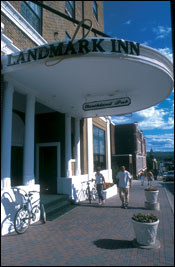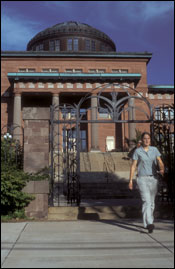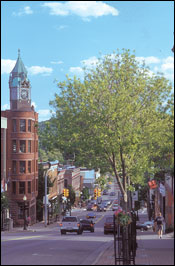MLUI / Articles from 1995 to 2012 / Marquette’s Landmark Inn
Marquette’s Landmark Inn
 | |
| MLUI/Gary Howe | |
| The $6.2 million restoration of the Landmark Inn helped inspire $40 million in new, private, business district investment. |
On November 3, 1995 Bruce and Christine Pesola spent $103,000 to buy the old Northland Hotel in downtown Marquette. Once one of the Upper Peninsula’s finest hotels, it was a boarded-up and leaky 65-year-old brick repository for pigeon droppings and a skunk carcass. At that time, the historic six-story hotel, which overlooks Marquette’s harbor from its tallest bluff, reflected the downtown. The ragged building on the hill and the listless streets at its feet were growing ungracefully old together.
Buying the hotel and spending 18 months transforming it into the handsome Landmark Inn was one of the most significant investments made in Marquette in years. Marquette’s merchants, bankers, and economic developers credit the Pesolas’ $6.2 million restoration with helping trigger more than $40 million in new business district investment since the late 1990s, much of it privately financed.
Resurrecting a Longtime Tradition
Other restoration projects also contributed to the recent upswing. In fact, Marquette has long valued its history. The city participated in a Main Street program in the 1980s. The Arch and Ridge Historic District was listed in the National Register of Historic Places in 1980.
In 1982 the community funded a $2.4 million restoration of the 1902 Marquette County Courthouse — the backdrop for the movie “Anatomy of a Murder”— rather than build a new one. Significant buildings constructed of red Lake Superior sandstone, such as the 1897 Harlow Block and the 1894 Richardsonian Romanesque city hall, have also been preserved and continue to define the community’s character.
 | |
| MLUI/Gary Howe | |
| Marquette funded restoration of the county courthouse, the backdrop for the movie "Anatomy of a Murder. |
But it was the Landmark Inn project that disturbed the downtown’s 20-year slumber and made it one of Michigan’s liveliest small towns. The city’s Lake Superior waterfront is now a welcoming public park. Biking, hiking, and cross-country skiing trails run through it and connect the lakeshore and surrounding forests. Offices, shops, clubs, coffeehouses, and restaurants grace 19th- and early 20th-century buildings, many of them newly restored. Citizens and philanthropists spent $9 million restoring the municipal library; the city’s population has stabilized even as Marquette County’s slips.
Meanwhile, the Landmark Inn attracts occupancy rates of 70 percent year-round and 90 percent in the summer, well above the rates of other, nearby hotels or motels.
“I guess it’s taken me this long, seven or eight years, to realize what we did, to have so many people tell me what a great thing it is,” Mr. Pesola said in an interview. “But I had no idea how hard it would be. It took everything I had, everything Christine had, to keep going. We just didn’t give up.”
Old Memories, New Dreams
Mr. Pesola, who grew up just down the block from the hotel, was a developer whose largest project had been a mid-size condominium development. But it was the Pesolas’ personal connection to Marquette that sparked the project. She worked as a waitress at the hotel while attending nearby Northern Michigan University; he used to warm himself by the great lobby’s fireplace during wintry walks home from school. Mr. Pesola said he was tired of seeing so many of Marquette’s historic buildings becoming parking lots.
“They tore down my Catholic grade school, my high school, even my church,” he said. “I wasn’t going to let them tear down this hotel.”
He and his wife agreed on a business plan that included a pub, two restaurants, and restoring the public spaces in historic detail. The couple put private baths in every room and decorated them with antiques and collectables so each was unique. The Michigan State Historic Preservation Office recommended it be eligible for a federal historic preservation tax credit. The Pesolas got a $1.1 million credit, sold it to raise cash, and invested oceans of their own sweat equity.
At about the same time, another NMU graduate and successful businessman, Rhys Mussman, returned to the area. He discovered that an entire block of buildings just down Front Street from the Landmark, including an old college hangout, the Rosewood Inn, was to be demolished. He bought the block and privately financed its rehabilitation. It took almost a decade; today it includes a beautifully restored bar, restaurant, and music venue called Upfront and Company, plus residential units, storefronts, and offices.
Slow Start for a Big Success
The Landmark Inn opened in May 1997 to earnest civic applause. It almost shut its door soon after — a near victim of ineffective marketing. Its first-year occupancy rate was 40 percent, half of what was needed. “We came close to having to close every day for the first two years,” said Ms. Pesola, who now directs a staff numbering 80 employees. “It was very scary.”
 | |
| MLUI/Gary Howe | |
| Ambitious restoration projects along Front Street awoke Marquette from a 20-year slumber |
But gradually word of Marquette’s many newly restored, gracious buildings spread. Today, the hotel and the town are doing much better than they have in a long time. Steve White, treasurer of the Marquette Downtown Development Authority, said the Inn and the downtown match perfectly.
“Study after study shows that the number-one activity of tourists is shopping,” Mr. White said. “The Landmark brings in a type of tourist that otherwise wouldn’t want to stay in Marquette. They hang around, and they buy. To that extent, they have helped keep the retail folks downtown. We don’t hear merchants complaining anymore about how bad business is.”
More to Come
The DDA builds on these newfound opportunities. It erects signs on historic buildings that tell their colorful stories to the tourists that wander its downtown streets. It helps businesses fix up the rear store entrances that now face the new ski and bike trails.
Another project, called Marquette Commons, will provide a downtown winter gathering spot with an artificial ice surface for skating. The city is also considering proposals for more downtown residential space. Mr. White said the challenge is finding more parking.
More investors are getting involved in the town’s comeback. One purchased several abandoned buildings along the waterfront and is converting them into condominiums and office and retail space. Every day, it seems, private citizens and civic leaders are joining the parade the Pesolas helped to start.
“For downtown, the Landmark Inn fits everything together,” said Dennis Mingay, who manages Getz’s, a department store that’s in a renovated, 100-year-old building down the hill from the hotel. “It’s a very important part of why people love this downtown.”





